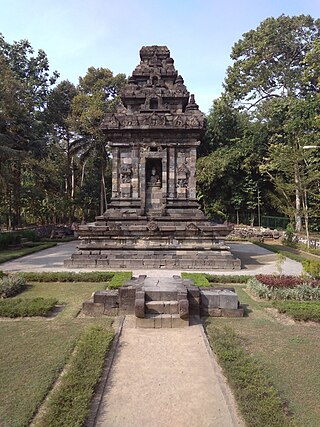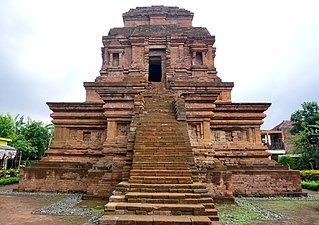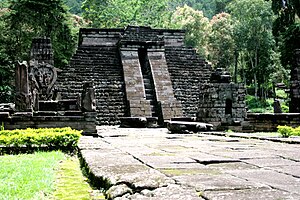
Prambanan is a 9th-century Hindu temple compound in the Special Region of Yogyakarta, in southern Java, Indonesia, dedicated to the Trimūrti, the expression of God as the Creator (Brahma), the Preserver (Vishnu) and the Destroyer (Shiva). The temple compound is located approximately 17 kilometres (11 mi) northeast of the city of Yogyakarta on the boundary between Central Java and Yogyakarta provinces.

Hinduism has historically been a major religious and cultural influence in Java, Indonesia. Hinduism was the dominant religion in the region before the arrival of Islam. In recent years, it has also been enjoying something of a resurgence, particularly in the eastern part of the island.

Ratu Boko or Ratu Boko Palace is an archaeological site in Java. Ratu Boko is located on a plateau, about three kilometres south of Prambanan temple complex in Yogyakarta, Indonesia. The original name of this site is still unclear, however the local inhabitants named this site after King Boko, the legendary king mentioned in Roro Jonggrang folklore. In Javanese, Ratu Boko means "Stork King".

A candi is a Hindu or Buddhist temple in Indonesia, mostly built during the Zaman Hindu-Buddha or "Hindu-Buddhist period" between circa the 4th and 15th centuries.

Surawana is a Hindu temple, of the Majapahit Kingdom, located in the Canggu village of the Kediri near Pare district in East Java, Indonesia. It was believed to have been built in 1390 AD as a memorial to Wijayarajasa, the Prince of Wengker. As of today the temple is not fully intact. Only the base of the temple has been restored to its original form and many more bricks are waiting around the structure to be reassembled.

The Lawu, or Mount Lawu is a massive compound stratovolcano straddling the border between Ngawi, East Java and Central Java, Indonesia. The north side is deeply eroded and the eastern side contains parasitic crater lakes and parasitic cones. A fumarolic area is located on the south flank at 2,550 m. The only reported activity of Lawu took place in 1885 when rumblings and light volcanic ash falls were reported. The recent study provided insights into geothermal heat flow suggesting that Mt. Lawu is still active today.

Pugung Raharjo is a 30 hectares archaeological site in the regency of East Lampung regency of Lampung Province in South Sumatra in Indonesia. The site was discovered in 1957. There is an ancient terraced megalithic structure, also known as Pugung Raharjo Pyramid. There other megalithic structures from the 12th to 16th century CE, including Menhirs and Dolmen, as well as prehistoric remains dating back to 2500 BC. It is locally known as the "Taman Purbakala Pugung Raharjo". It is situated approximately 50 km from the provincial capital, Bandar Lampung.

The Ceto is a fifteenth-century Javanese-Hindu temple that is located on the western slope of Mount Lawu on the border between Central and East Java provinces.
Indonesian Esoteric Buddhism was the tradition of Esoteric Buddhism found in Maritime Southeast Asia which emerged in the 7th century along the maritime trade routes and port cities of the Indonesian islands of Java and Sumatra as well as in Malaysia. These esoteric forms were spread by pilgrims and Tantric masters who received royal patronage from royal dynasties like the Sailendras and the Srivijaya. This tradition was also linked by the maritime trade routes with Indian Vajrayana, Tantric Buddhism in Sinhala, Cham and Khmer lands and in China and Japan, to the extent that it is hard to separate them completely and it is better to speak of a complex of "Esoteric Buddhism of Mediaeval Maritime Asia." Many key Indian port cities saw the growth of Esoteric Buddhism, a tradition which coexisted alongside Shaivism.

Penataran or Panataran is one of the largest Hindu temple ruins complexes in East Java, Indonesia. It is located in Penataran, Blitar Regency, roughly 12 km northeast of Blitar, with the closest airport being farther away at Malang. Believed to have been constructed between the 12th century to the 15th century, the temple played a significant role in the Majapahit Kingdom, especially under King Hayam Wuruk. He considered it his favorite sanctuary. Penataran dates from the Kediri era.

Prambanan Temple Compounds is the World Heritage designation of a group of Hindu temple compounds that lie on the border between Yogyakarta and Central Java, Indonesia. It comprises Prambanan, Lumbung, Bubrah and Sewu temple compounds, all are located within Prambanan Archaeological Park.

Sambisari is a 9th-century Hindu temple located at Sambisari hamlet, Purwomartani, Kalasan, Sleman Regency, Special Region of Yogyakarta, Indonesia. The temple was buried about five metres underground. Parts of the original temple have been excavated. The temple is located about 8 kilometres (5.0 mi) east of Yogyakarta near Adisucipto International Airport.

Jawi temple is a syncretic Hindu-Buddhist candi (temple) dated from the late 13th century Singhasari kingdom. The temple is located on the eastern slope of Mount Welirang, Candi Wates village, Kecamatan Prigen, Pasuruan, East Java, Indonesia, approximately 31 kilometers west of Pasuruan city or 41 kilometers south of Surabaya. The temple is located on the main road between Kecamatan Pandaan – Kecamatan Prigen and Pringebukan. The temple was thought to be a Hindu-Buddhist place of worship, however, the temple was dedicated as a mortuary temple to honor King Kertanegara, the last king of Singhasari. It is believed that the ashes of the late king were also placed in two more temples, the Singhasari temple and the Jago temple.

Merak temple, or locally known as Candi Merak, is a 10th-century Javanese Shivaist Hindu temple complex located in Karangnongko village, in Klaten Regency, northwest from Klaten town, Central Java, on southeastern slopes of Mount Merapi. The temple complex consisted of a main building and three perwara (ancillary) temples, dating from the 9th or 10th century, from the Mataram Kingdom.

Javanisation or Javanization is the process in which Javanese culture dominates, assimilates, or influences other cultures in general. The term "Javanise" means "to make or to become Javanese in form, idiom, style, or character". This domination could take place in various aspects; such as cultural, language, politics and social.

Gunung Gangsir is an 11th-century Hindu candi (temple) located approximately 5 kilometers west from the town of Bangil. This red brick structure is located in Gunung Gangsir village, Beji subdistrict, Pasuruan Regency, East Java Indonesia.

Badut is an 8th-century Hindu temple located in Tidar area around 5 kilometres (3 mi) west from the center of Malang city. This andesite stone structure is located in Karang Besuki village, Dau subdistrict, Malang Regency, East Java Indonesia.

Candi Kethek is a terraced megalithic pyramid-shaped 15th-16th century Hindu temple on the northwest slope of Mount Lawu in Anggrasmanis village of Gumeng subdistrict in Jenawi district of Karanganyar Regency in Central Java of Indonesia. The temple has seven terraces facing west, each terrace is connected by stone steps. There is an alternative path to the top terrace on the south side. Kethek Temple is located northeast of the fifteenth-century Javanese-Hindu Ceto Temple. To reach Candi Kethek, visitors must take a 300 m footpath from Ceto Temple in the direction of the path leading to Puri Taman Saraswati.
Lebak Cibedug temple, is a terraced pyramid shaped sacred megalithic site on the bank of Cibedug river near Citorek village in Banten Province at the west end of the island of Java, Indonesia. There are other megalithic menhirs and dolmens on this site.



























